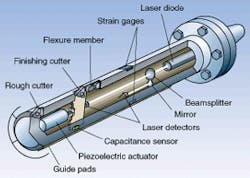AUTOMOTIVE MANUFACTURING: Laser guidance speeds hole boring
With guidance from a laser-diode-based navigation system housed within its body, a cutting tool on a new line-boring machine can move more than ten times faster than the wings of a hummingbird (they beat some 60 times per second). The "smart" boring tool on the BOA (boring with optimal accuracy) machine compensates in real time for machine vibration and gravitational forces by adjusting the location of one of its two cutting inserts as many as 1000 times per second (approximately 30 times per revolution of the tool).
Lamb Technicon Machining Systems (Warren, MI) designed both the boring bar and the BOA machine tool to provide a flexible, accurate alternative to dedicated line-boring machines. Technical assistance was provided by engineering staff at the University of Michigan (Ann Arbor, MI). Partial funding for the R&D project came from the National Institute of Standards & Technology (Gaithersburg, MD) through the Department of Commerce's Advanced Technology Program.
Combining machining flexibility with line-boring accuracy is not easy. A typical automotive application requires cutting holes through the bearing brackets (journals) that mount camshafts on top of the engines. The tool, which is used in place of a conventional boring bar, must pass through several holes, each no more than 10 to 20 µm off-center. Machining must be accurate to ensure that a camshaft will rotate freely without friction or vibration. The tool must perform this operation 1400 times per day to keep up with the production demands of a typical engine plant.
One possible problem stems from a tool length-to-diameter ratio that can reach 30:1. The greater the tool overhang, the more likely the tool is to deflect during cutting. The resulting vibration can reduce both dimensional and geometric accuracy in the bore. Dedicated boring machines compensate for such forces with highly engineered frames and bracing, but there is little flexibility to modify processing or to upgrade equipment. To introduce flexibility into the line-boring process without limiting hole-making accuracy, Lamb Technicon researchers realized that they had to redesign both the machine tool and the cutting tool.
Engineers theorized that a boring bar with an adjustment range of 50 to 100 µm could compensate for the vibrations produced by most boring applications if two conditions are met. First, there must be the capability to measure the vibratory motions and generate a control signal for the compensation device. Second, there should be real-time compensation for toolholder motion.
At high cutting speeds, however, such active control of the boring bar requires the tool sensor and controller to be in continuous communication. Signal feedback from a conventional machine-tool controller may not be fast enough. Lamb Technicon solved the problem by building a real-time controller within the tool body dedicated to tool compensation. The controller receives location data related to the tool's finishing cutter from a laser-diode-based guidance system also housed in the tool body, calculates required tool adjustments, and sends that data to a sensor-based actuation system. This device then adjusts a specially designed flexure member upon which the finishing cutter is mounted (see figure). The closed-loop real-time control process uses laser-based guidance because the high-speed rotation of the tool body (up to 5000 rpm) does not degrade feedback sent to the controller.
During equipment development, researchers measured the accuracy of the laser system on a steel boring bar 10.87 in. in length, with an outer diameter of 2.44 in. and an inner diameter of 0.75 in. The navigation system included a laser detector (UDT Sensors; Hawthorne, CA) with a sensing area of 0.98 x 0.98 in. A 670-nm laser diode (Melles Griot; Carlsbad, CA) produced a beam with output power of 1.2 mW. The output of the laser detector was directed into a data acquisition system set to sample data at 5000 points/s. Another experiment measured the efficiency of the control processsignal transfer from laser system to control to actuator. The experiments indicated that the adaptive boring equipment could contain the signal-tracking error to within 1 µm in the closed-loop control concept with a laser-based navigation system in place.
The BOA machine and smart tool will premiere at the IMTS 2000 machine tool show this September in Chicago, IL. According to Lamb Technicon, the flexible boring technology may one day make it possible to accurately bore an oval hole to accommodate oval pistons and combustion chambers, the goal being to improve engine efficiency.
About the Author
Paula Noaker Powell
Senior Editor, Laser Focus World
Paula Noaker Powell was a senior editor for Laser Focus World.
